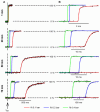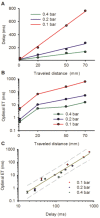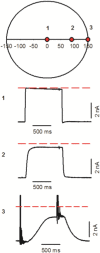Dynamics of T-Junction Solution Switching Aimed at Patch Clamp Experiments
- PMID: 26177538
- PMCID: PMC4503516
- DOI: 10.1371/journal.pone.0133187
Dynamics of T-Junction Solution Switching Aimed at Patch Clamp Experiments
Abstract
Solutions exchange systems are responsible for the timing of drug application on patch clamp experiments. There are two basic strategies for generating a solution exchange. When slow exchanges are bearable, it is easier to perform the exchange inside the tubing system upstream of the exit port. On the other hand, fast, reproducible, exchanges are usually performed downstream of the exit port. As both strategies are combinable, increasing the performance of upstream exchanges is desirable. We designed a simple method for manufacturing T-junctions (300 μm I.D.) and we measured the time profile of exchange of two saline solutions using a patch pipette with an open tip. Three factors were found to determine the timing of the solution switching: pressure, travelled distance and off-center distance. A linear relationship between the time delay and the travelled distance was found for each tested pressure, showing its dependence to the fluid velocity, which increased with pressure. The exchange time was found to increase quadratically with the delay, although a sizeable variability remains unexplained by this relationship. The delay and exchange times increased as the recording pipette moved away from the center of the stream. Those increases became dramatic as the pipette was moved close to the stream borders. Mass transport along the travelled distance between the slow fluid at the border and the fast fluid at the center seems to contribute to the time course of the solution exchange. This effect would be present in all tubing based devices. Present results might be of fundamental importance for the adequate design of serial compound exchangers which would be instrumental in the discovery of drugs that modulate the action of the physiological agonists of ion channels with the purpose of fine tuning their physiology.
Conflict of interest statement
Figures








Similar articles
-
Catch and Patch: A Pipette-Based Approach for Automating Patch Clamp That Enables Cell Selection and Fast Compound Application.Assay Drug Dev Technol. 2016 Mar;14(2):144-55. doi: 10.1089/adt.2015.696. Assay Drug Dev Technol. 2016. PMID: 26991363
-
Flow characterization and patch clamp dose responses using jet microfluidics in a tubeless microfluidic device.J Neurosci Methods. 2017 Nov 1;291:182-189. doi: 10.1016/j.jneumeth.2017.08.025. Epub 2017 Aug 23. J Neurosci Methods. 2017. PMID: 28842193 Free PMC article.
-
Practical limits on the maximal speed of solution exchange for patch clamp experiments.Biophys J. 1999 Aug;77(2):682-90. doi: 10.1016/S0006-3495(99)76923-7. Biophys J. 1999. PMID: 10423417 Free PMC article.
-
Electrophysiology in the eukaryotic model cell Saccharomyces cerevisiae.Pflugers Arch. 1998 Nov;436(6):999-1013. doi: 10.1007/s004240050735. Pflugers Arch. 1998. PMID: 9799419 Review.
-
[Advancement of patch-clamp technique and its application in drug high-throughput screening].Sheng Li Ke Xue Jin Zhan. 2005 Apr;36(2):125-9. Sheng Li Ke Xue Jin Zhan. 2005. PMID: 16222971 Review. Chinese.
References
-
- Hille B. Ion channels of excitable membranes. Edition 3. Hille B, editor2001. i-xviii, 1–814 p.
-
- Newell JG, McDevitt RA, Czajkowski C. MUTATION OF A GABAA RECEPTOR BINDING SITE RESIDUE PRODUCES A CONSTITUTIVELY OPEN CHANNEL . Society for Neuroscience Abstract Viewer and Itinerary Planner. 2002;2002:Abstract No. 40.3-Abstract No. .3. .
Publication types
MeSH terms
Substances
LinkOut - more resources
Full Text Sources
Other Literature Sources
Research Materials

